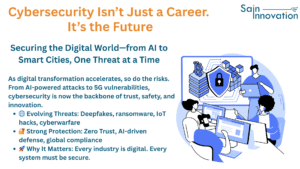
Sain Innovation Cybersecurity
Cybersecurity represents the future of digital safety and trust because every step toward
digital transformation creates new risks that must be secured. As organizations, governments,
and individuals embrace modern technologies—AI, cloud computing, IoT, 5G, smart cities,
fintech, healthcare technology, and e-governance—they also open doors to new attack
surfaces and vulnerabilities. Here’s how:
Each new technology introduces vulnerabilities, from misconfigured cloud servers to
unsecured IoT devices or AI model manipulation. For example, 5G’s low latency boosts
connectivity but also enables faster, more sophisticated attacks like DDoS or data
interception. Similarly, smart cities rely on interconnected systems, making them prime
targets for ransomware or supply chain attacks.
The stakes are high: a single breach can disrupt critical infrastructure, expose sensitive data,
or damage public trust. With ransomware attacks rising 13% globally in 2024 and average
breach costs reaching $4.88M (IBM), governments and organizations are adopting zero-trust
models, advanced encryption, and AI-driven defenses. Yet, cybercriminals continue to adapt,
leaving both organizations and individuals—facing threats like phishing and identity
theft—at constant risk.
Cybersecurity’s role is to bridge the gap between innovation and safety, ensuring trust in
digital systems. It’s not just about defending against threats but enabling secure adoption of
transformative tech. What specific area of cybersecurity—like zero trust, threat intelligence,
or IoT security—are you most curious about?
1. Evolving Threats
● AI-powered attacks: Hackers now use AI for deepfakes, phishing automation, and
malware that adapts in real time.
● Ransomware & cyber extortion: Attacks are shifting from individuals to critical
infrastructure (hospitals, power grids, banks).
● IoT & 5G vulnerabilities: Billions of connected devices open new doors for
cybercriminals.
● Cloud and remote work risks: Data leaks, insider threats, and misconfigurations are
rising with hybrid workplaces.
● Nation-state cyberwarfare: Countries are increasingly using cyberattacks as
weapons, turning conflicts into cyber wars between nations and making cybersecurity
a critical element of national security.
2. The Need for Strong Protection
● Data → Organizations rely on sensitive data for operations, making security
non-negotiable.
● Zero Trust architecture → Future security relies on the principle of “never trust,
always verify,” ensuring continuous authentication, monitoring, and protection across
all systems.
● Compliance & regulations → Governments worldwide enforce strict data privacy
laws (GDPR, India’s DPDP Act, etc.).
● AI in Défense → Just as attackers use AI, defenders must deploy AI-driven threat
detection and automation.
● Cyber resilience → Beyond protection, businesses must prepare to recover quickly
after an incident.
3. Why It Represents the Future: The future is completely dependent on strong
security—making cybersecurity a core component of every digital transformation.
● Digital-First Economy: Every industry—banking, healthcare, education, and
Défense—is moving online, making security essential for survival.
● Skill demand: Cybersecurity professionals are among the most in-demand jobs
worldwide.
● Innovation driver: New technologies (blockchain, quantum cryptography) are being
developed purely to enhance security.
Note: In short, cybersecurity is not just a technical function anymore—it’s a strategic pillar
for businesses, governments, and individuals in the future digital world